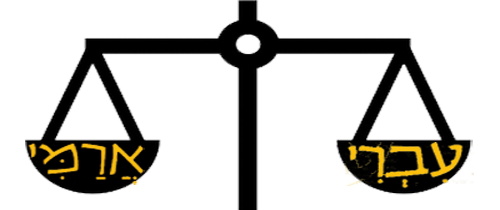Modern interest in the Aramaic language arose with the “discovery” of the Aramaic-speaking churches of the east in the sixteenth century. Here, finally, it was believed, Jesus’ “mother-tongue” had been found, and the earliest treatises about the Jewish vernacular in the time of Jesus were written by de Rossi (1772)[1] and Pfannkuche (1798)[2] on the basis of this assumption. These treatises remained the only ones in the field until the studies of Dalman in 1894 and following.[3] Throughout these approximately one hundred years, scholars firmly believed in the exclusive use of Aramaic, and this belief permeated works of New Testament scholarship. By the end of the nineteenth century this belief had almost reached the status of infallibility.
For this reason, even the word “Hebrew” in the New Testament, as well as in Josephus and Philo, was believed to refer to the Aramaic language. Wordlists of Semitic terms in the New Testament were compiled and carefully checked against the Aramaic lexicon known at that time; however, these lists were never equally crosschecked against the Hebrew lexicon. In this way, even some clearly Hebrew terms ended up in the lists of Aramaic words. As Joseph A. Fitzmyer, one of the world’s more prominent Aramaic scholars, admitted in 1975 in hindsight: “…the way in which claims are sometimes made for the Aramaic substratum of the sayings of Jesus, when the evidence is merely “Semitic” in general, or, worse still, derived from some other Semitic language, e.g., Hebrew, should no longer be countenanced.”[4]
What we have to keep in mind is how thin was the evidence upon which scholars based their observations. They did not have the Dead Sea Scrolls or the Cairo Genizah. There were no Bar Kochva letters or documents from Nahal Hever. There was no Targum Neofiti and no Hebrew fragments of Ben Sira. Archaeology in the Holy Land had only just begun and the epigraphic evidence was minimal. Therefore, some of the scholarly conclusions of these pioneers in the field, as learned as the conclusions were in their day, have to be revised from today’s perspective. For example, in 1798 Pfannkuche referred to the “Year 1” coins as proof that Aramaic was the vernacular as early as Hasmonean times. Today we know that these coins were minted during the first Jewish revolt and their language is Hebrew. Pfannkuche and Dalman dated the Targums of Onkelos and Jonathan to Hellenistic times and believed they reflected the language spoken at the time of Jesus. Today these Targums are dated centuries later, and so is their language. Julius Wellhausen noticed the late date of the Targumic language and acknowledged that no textual evidence for “Palestinian Jewish Aramaic” was available. Therefore, he took most of his Aramaic material from the Palestinian-Christian lectionaries of the third and fourth centuries A.D.[5]
Paid Content
Premium Members and Friends of JP must be logged in to access this content: Login
If you do not have a paid subscription, please consider registering as a Premium Member starting at $10/month (paid monthly) or only $5/month (paid annually): Register
One Time Purchase Rather Than Membership
Rather than purchasing a membership subscription, you may purchase access to this single page for $1.99 USD. To purchase access we strongly encourage users to first register for a free account with JP (Register), which will make the process of accessing your purchase much simpler. Once you have registered you may login and purchase access to this page at this link:
- [1] Giovanni Bernardo De Rossi Della Lingua Propria Di Cristo E Degli Ebrei Nazionali Della Palestina Da Tempi de Maccabei (Parma: Stamperia Reale, 1772). ↩
- [2] Heinrich Friedrich Pfannkuche, “Über die palästinische Landessprache in dem Zeitalter Christi und der Apostel. Ein Versuch, zum Theil nach de Rossi entworfen,” in: Allgemeine Bibliothek der biblischen Literatur (ed. Johann Gottfried Eichhorn; Achter Band; Drittes Stück; Leipzig: Weidmannsche Buchhandlung, 1798), 365-80. ↩
- [3] Gustaf Dalman, Grammatik des jüdisch-palästinischen Aramäisch nach den Idiomen des palästinischen Talmud und Midrasch, des Onkelostargum (cod. Sorini 84) und der jerusalemischen Targume zum Pentateuch (Leipzig: Hinrichs, 1894); idem, Aramäische Dialektproben: Lesestücke zur Grammatik des jüdisch-palästinischen Aramäisch zumeist nach Handschriften des Britischen Museums (Leipzig: Hinrichs, 1896); Gustaf Dalman and G. H. Händler, Aramäisch-neuhebräisches Handwörterbuch zu Targum, Talmud und Midrasch. Mit Vokalisation der Targumischen Wörter nach südarabischen Handschriften und besonderer Bezeichnung des Wortschatzes des Onkelostargum (Frankfurt a.M.: Kaufmann, 1897); Gustaf Dalman, Die Worte Jesu: mit Berücksichtigung des nachkanonischen jüdischen Schrifttums und der aramäischen Sprache erörtert (Leipzig: Hinrichs, 1898). ↩
- [4] Joseph A. Fitzmyer, “The Study of the Aramaic Background of the New Testament” (1975), reprinted in Joseph A. Fitzmyer, A Wandering Aramaean: Collected Aramaic Essays (Missoula, MT: Scholars Press, 1979): 5. ↩
- [5] Julius Wellhausen, Einleitung in die drei ersten Evangelien (Berlin: Georg Reimer, 1905), 38-42. ↩































































































